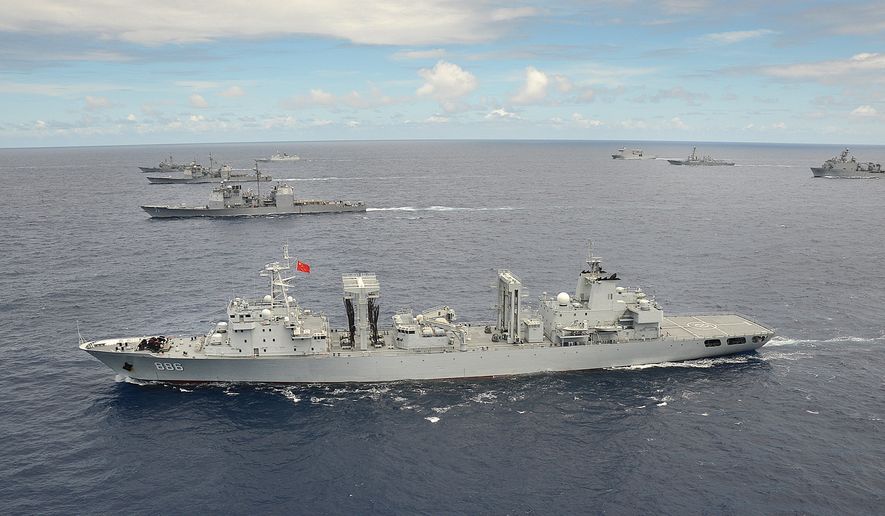A contingent of five Chinese warships is set to sail alongside U.S. and allied vessels when the world’s biggest maritime naval exercises kick off Thursday — despite rising tensions and occasional standoffs between Chinese and U.S. forces in the increasingly sharp struggle for dominance in the South China Sea.
The Chinese navy will be participating in the biennial Rim of the Pacific naval war games for only the second time ever.
Some see the move in what U.S. defense officials call RimPac 2016 as a long-awaited olive branch by Beijing to the U.S. and its regional allies, and others fear it is a calculated gesture to further reinforce aggressively sought gains in the South China Sea and elsewhere in the Pacific.
Adding to the political overtones of China’s participation will be a July 12 ruling, right in the middle of the exercises, by an international tribunal on a closely watched Philippine complaint about Beijing’s broad claims of sovereignty in the South China Sea, one of the world’s most strategic waterways.
China will join the United States and 25 other nations in the Rim of the Pacific naval war games, which are designed to improve combat coordination and cooperation among the Asia-Pacific’s maritime powers. They also have become the largest showcase of American naval power in the region.
The exercises, to be held off the coast of California and near the Hawaiian Islands, will be the 25th since 1971. China has participated only in 2014.
The China invitation has raised eyebrows on Capitol Hill and criticism from some private analysts, but U.S. military leaders have lauded RimPac 2016 as an opportunity to engage with Beijing and perhaps encourage it to take a softer line on regional maritime clashes.
“While we have disagreements with China, especially over its destabilizing behavior in the South China Sea, we are committed to working with them and to persuade them to avoid self-isolation,” Defense Secretary Ashton Carter said in a speech last week to the Center for a New American Security.
Adm. John Richardson, chief of naval operations, is slated to travel to Beijing for the first face-to-face meeting with his Chinese counterpart, Adm. Wu Shengli, since taking the top Navy job.
Chinese naval forces participated in the Rim of the Pacific drills in 2014 at the behest of the Pentagon, but their role involved only a handful of top Chinese naval officials and a single ship.
This year, the Chinese navy is expected to field five ships, including two guided missile warships and a submarine rescue ship, along with a complement of nearly 1,500 sailors, according to reports of Beijing’s plans. China’s role in the Pacific drills represents a “new type of major power relationship” between Washington and Beijing, Chinese Deputy Navy Commander Wang Hei told the official Xinhua News Agency.
That participation could put U.S. interests in the Pacific at a major disadvantage, said Dean Cheng, a senior Pacific security analyst with The Heritage Foundation.
Extending the offer to China to take part in the Pacific Rim exercises is tantamount to rewarding the country’s military belligerence, particularly in places like the South China Sea, by granting China access to American naval strategy, Mr. Cheng said.
The invitation to the Pacific Rim exercises “makes it very clear that the United States feels incumbent to [reach out] to China” while turning a blind eye to its military transgressions, he said.
But some analysts say the invitation was a quiet signal from the Pentagon that the tensions in the South China Sea do not mean the U.S. and China cannot cooperate in other security fields.
“The fact that the U.S. and China do not see eye to eye on the issue of the South China Sea does not hinder military engagements, exchanges and dialogues,” Yun Sun, a China analyst at the Washington-based Stimson Center, told The Japan Times newspaper this week. “In fact, it makes them even more important than before.”
Bad behavior
The cat-and-mouse game between China and the U.S. and its Pacific allies boiled over recently when Beijing scrambled a team of fighter jets to track a U.S. warship as it sailed by a disputed patch of land in the heart of the South China Sea.
Although past incidents raised the hackles of military leaders in Beijing and Washington, most were resolved quietly through diplomatic channels. But the Chinese response to the U.S. ship’s traverse through the Fiery Cross was particularly sharp.
In May, two Chinese fighter jets had a dangerous confrontation with a U.S. patrol plane in international airspace over the South China Sea.
A Navy EP-3 Orion surveillance aircraft was conducting a routine mission above the hotly contested waterway when J-11 Shenyang fighters intercepted the Navy spy plane and flew within 50 feet of it.
“Initial reports characterized the incident as unsafe,” said Lt. Col. Michelle Baldanza, a Pentagon spokeswoman.
Such incidents, Mr. Cheng said, are clear signs that the Pentagon’s strategy is buckling under rising tensions driven by Beijing’s naked power play for control of the strategic waters off the Chinese coast.
One scenario that could escalate tensions further is the ruling in the Philippines case, filed with the Permanent Court of Arbitration based in The Hague.
Manila is challenging China’s territorial claims in the South China Sea, particularly efforts to build up military installations on rocky outcroppings in the Spratly Islands, the Scarborough Shoal, the Fiery Cross Reef and other strategic points.
Chinese officials have repeatedly stated that they do not recognize the court’s authority in the South China Sea dispute and will not adhere to the decision if it finds in favor of the Philippines.
Behind closed doors, China also has threatened to establish a no-fly zone over the disputed shoal if the decision goes against Beijing, said Mr. Cheng, adding that “things are getting to be more dangerous all the time” in the Pacific.
• Carlo Muñoz can be reached at cmunoz@washingtontimes.com.




Please read our comment policy before commenting.